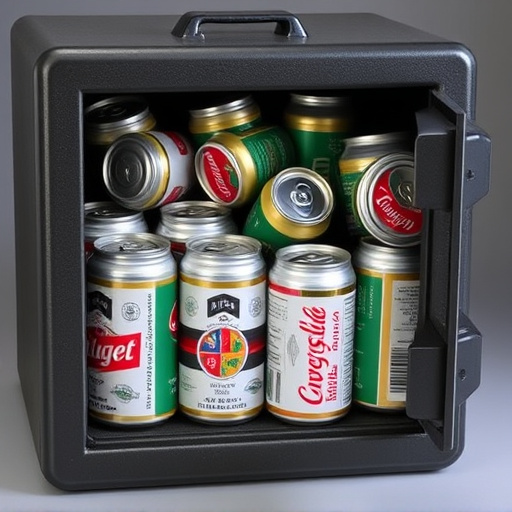In today's digital age, remote work and online shopping have made homes more vulnerable to burglaries. To address this, "Fake Household Items for Storage" have emerged as innovative security measures that blend discreetly into everyday life. These solutions include hidden compartments in books, electrical outlets, and furniture, offering a subtle yet effective way to protect valuable assets without using conventional safes. This creative approach adds an element of fun and surprise while ensuring security.
In today’s digital age, discretion is key. As we store sensitive data on our devices, it’s crucial to also safeguard tangible valuables discreetly. This is where hidden security storage comes into play, offering a unique solution with surprising benefits—fake household items as safes.
This article explores the growing trend of integrating concealed storage within everyday objects, particularly using cleverly designed fake household items for secure and unassuming protection of your precious possessions.
- Understanding the Need for Discreet Storage Solutions
- Unveiling the Concept: Fake Household Items as Safes
- Types and Applications of Hidden Security Storage
- Benefits, Considerations, and Best Practices
Understanding the Need for Discreet Storage Solutions
In today’s digital age, where privacy and security are paramount, there is a growing need for discreet storage solutions that can protect valuable items from prying eyes. The rise of remote work and online shopping has made homes more susceptible to burglaries, prompting individuals to seek creative ways to safeguard their possessions. This is where fake household items for storage come into play as innovative and often under-the-radar security measures.
By integrating seemingly innocuous everyday objects with hidden compartments, these solutions offer a subtle yet effective way to conceal and secure valuable assets, such as precious metals, important documents, or even emergency funds. Fake products like fake books, faux electrical outlets, or cleverly designed furniture pieces not only blend seamlessly into the background of your home but also provide an extra layer of protection for sensitive items that conventional safes might not accommodate.
Unveiling the Concept: Fake Household Items as Safes
In today’s digital age, where privacy and security are paramount, an innovative concept has emerged—hiding your precious items within everyday household objects. Unveiling this idea involves transforming seemingly innocuous fake household items into secure storage spaces for valuable possessions. By designing faux replicas of common items like books, plants, or even kitchen appliances, creators offer a creative solution to those seeking discreet and unique hiding spots.
These fake household items for storage provide an intriguing twist on traditional safes, allowing individuals to keep their belongings hidden in plain sight. Whether it’s a collection of rare coins stashed inside a replica book or jewelry concealed within a lifelike artificial plant, the possibilities are endless. This approach not only offers discreet security but also adds a layer of fun and surprise, making it an appealing option for those looking to protect their assets with a touch of cleverness.
Types and Applications of Hidden Security Storage
Hidden security storage, often disguised as everyday household items, offers a creative and stealthy approach to safeguarding valuable possessions. These innovative solutions come in various forms, each designed for specific needs and applications. One popular category is the use of fake household items, such as faux food tins or vintage-looking books, which can discreetly hide smaller valuables like keys, passwords, or even cash.
These fake products are meticulously crafted to look authentic, blending seamlessly into their surroundings. For instance, a cleverly designed fake can of soup or jar of pickles could provide secure storage in a kitchen pantry. Similarly, faux vintage novels or leather-bound journals serve as ideal hiding spots in an office or study setting. This type of hidden security storage is particularly appealing for those seeking discreet and unconventional ways to protect sensitive information or prevent unauthorized access to valuable items.
Benefits, Considerations, and Best Practices
Benefits
Using fake household items as hidden security storage offers a creative and discreet solution for securing valuable items or sensitive documents. These cleverly designed replicas blend seamlessly into everyday objects, making it difficult for intruders to identify their true purpose. For instance, a fake plant pot could hide a small safe, while a replica food item might conceal cash or valuables within its packaging. This innovative approach enhances home security by providing an additional layer of protection against burglaries or theft, without compromising aesthetic appeal.
Considerations and Best Practices
When opting for fake household items as storage, it’s essential to consider factors like quality and realism. High-quality fakes that closely resemble authentic items are more effective at deterring potential thieves. Always choose products designed specifically for security purposes, ensuring they’re durable and can withstand handling without raising suspicion. Additionally, consider the placement of these hidden safes. Discreet locations like bookcases, under furniture, or within fake electrical boxes work best to maintain realism while offering easy access for owners. Regularly updating and changing the storage spots adds an extra layer of complexity for intruders.
In conclusion, hidden security storage using fake household items offers a creative and discreet solution for safeguarding valuables. By integrating these innovative safes into everyday objects, individuals can enhance their home security without compromising aesthetics. With various types available, from magnetic to hidden compartments within seemingly innocuous items, this approach provides versatility for different needs. Always consider factors like durability, accessibility, and environmental conditions to ensure the best fit for your unique storage requirements.
